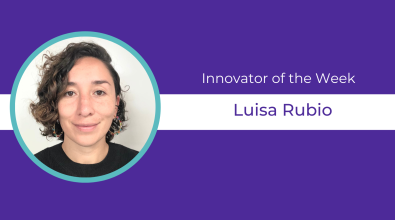How Denver is empowering students to take action on air quality
City and school officials survey an Air Quality Dashboard at Prep Academy in Denver. (Photo Source: Denver Department of Public Health & Environment.)
It’s never been easier to get data on air quality in your city, whether it’s on a weather app or on the local news. But for many people—especially those with asthma or other sensitivities to air pollution—citywide data isn’t good enough, as air quality is highly variable and can vary from neighborhood to neighborhood.
That’s why a growing number of cities have begun using sensors to track air quality in more granular ways. Last year, Philadelphia released its first report showing localized air-quality data in 50 neighborhoods. Kansas City, Mo., has used sensors to track air quality in COVID-19 hotspots. In Europe, Bloomberg Philanthropies is supporting efforts to measure and disseminate localized air-quality data in Brussels and London, and last week announced a new phase to similar work in Paris.
A pioneer in this field is Denver, which in 2018 won a $1 million grant through the Bloomberg Philanthropies Mayors Challenge to create a program aimed at helping protect students with asthma. The program, called Love My Air, uses sensors to track hyper-local air quality data at Denver Public Schools, and display the data online and at school, to help principals and parents make decisions about how much outdoor activity students should engage in. So far, the city has partnered with more than 30 schools on the project. Recently it developed a mobile app that residents will be able to use to track air quality from their phones, and to enable the city and school district to send out alerts and gather data from users.
Bloomberg Cities recently spoke with Aubrey Burgess, the Love My Air program coordinator, and Michael Ogletree, air quality program manager for the City and County of Denver, to learn more about the effort and how the program is leading a trend of cities using environmental data to help residents live healthier lives.
What is the Love My Air program, and what kinds of decisions are you hoping to influence?
Aubrey Burgess: We’ve been working with Denver Public Schools to install air quality sensors with the intent of raising awareness and empowering communities with data to make behavior changes around their health and reducing pollution. Specifically, it is targeting students with asthma. Denver Public Schools have a higher-than-average asthma rate that leads to increased cost burdens on families, time missed from school, and lower academic performance. So, we’re working with students and families with asthma and principals who can make decisions around alternative activities, as well as school nurses who help with asthma action plans. But it’s also raising general community awareness. The last few years, we’ve had a lot of impacts from wildfire smoke, so we’ve been getting a lot of inquiries from communities on what the average family needs to do to limit their exposure.
How do users see the data?
Burgess: They can see it in real time. The sensors go to a dashboard, LoveMyAir.com, and each school has a specific dashboard so kids can bookmark that page. It also lives on a TV monitor in schools in a main hallway, so when they’re on their way out to P.E. or recess they can take a look at that dashboard as well.
Did you target schools that were near refineries or highways or other areas that would be heavily polluted?
Michael Ogletree: We used a data-driven approach using asthma rates and free and reduced lunch rates and other datasets. We didn’t identify it based on local sources, but rather by the data.
Burgess: We looked at school readiness as a component, too—an enthusiastic teacher, school nurse, principal, someone who wants to really take this program and run with it. When there’s someone internally who can lead and get the information out to the school community, that’s where the impact is.
How did you get schools on board?
Burgess: Originally it was a lot of cold-calling around, reaching out, trying to build relationships with principals to get the initial buy-in. It’s been successful word of mouth. We’re up to 35 or 36 schools now. We’ve worked to target teachers and nurses specifically that have a high interest and can work to drive it in their schools. It was initially a data-driven approach of trying to nail in who those schools are, and then go in with a planned pitch that we would give to the principals.
Ogletree: As you can imagine, going to schools that have higher-than-average asthma rates and are in disproportionately impacted communities, there was some concern about measuring air quality at their schools and then having those things come out in the media, or schools losing enrollment. So, the pitch to them was around how they could use the program and proactively address some of those disparities. I think that worked.
What are your different stakeholders learning from these sensors?
Ogletree: There’s three levels to it—the individual level, the school community level, and then what we as Denver use. In terms of individual use, a child can walk through a corridor and look at the dashboard and then make a personal decision about, “OK, I’m more sensitive, and last time it was at this threshold it was affecting me.” And then the schools themselves can use that information, too. A nurse can use it to better inform how she explains the impact to her students, and principals can make decisions about how active the kids are outside. In terms of the city’s use of the data, we use it to see what’s going on over a geographic region. It’s filling in the gaps between other air monitoring stations.
Tell us about the app.
Burgess: We’ve been able to build out an air-quality app that has all of our different dashboards and all of our schools in one place, but also a map view. We have a lot of longer-term goals in terms of being able to send out push notifications. We could send out a push notification to a parent at a specific school saying, “Hey, it looks like you’re at your school right now. We’re in an anti-idling campaign, so please turn off your engine.” And then we can follow up with additional notifications: “Did you take any of the following behaviors to reduce your exposure during the air-quality action alert yesterday?” And then we can do some data collection. You’ll be able to put that information in your pocket. Just like you would check your weather app to make decisions about your day, you could look at air quality to make decisions about outdoor activities like walking or biking to work or school and then including some suggested actions around how to limit exposure, and limit pollution when air quality is good.
Currently we’re in a test version, so we sent that out to a few hundred people to review and provide some initial feedback. In the next month or two, we’ll do some additional edits to the app and get that ready for a more wide-scale release, and then do a bigger push out to our wider public-school community.
Have you heard from other cities that are trying to do this?
Ogletree: A lot of people locally, a lot of people nationally as well as internationally. I have a call with Mexico City tomorrow morning. We’ve had a lot of interest.
And is what you’re doing in Denver replicable elsewhere?
Burgess: We’ve been able to develop curriculum, programming, hire contractors to run focus groups and those kinds of things. Now that this tech and this data platform exist, an individual city can now contract out for a much lower cost: ongoing maintenance as opposed to trying to build a platform from scratch.
Ogletree: Our upfront investment was on program development, and developing all of this collateral so that if another municipality is interested they could probably put it in three to five schools for $15,000 a year. And that’s sensor, platform, all of the educational curriculum—everything, basically. They’ll just need a person to help implement it, but we’ve developed all of the components of it to be able to make it replicable in other municipalities.


